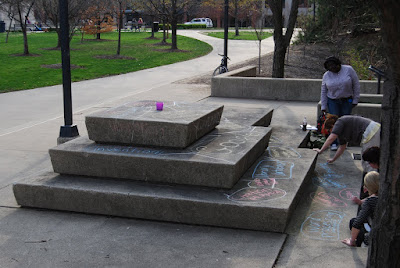
As we near the end of the Spring semester, the weather around Muncie has been steadily improving—the birds are out, singing their songs, the trees are budding, and flowers are blooming all over campus. This week, in both my grad and undergrad classes, we've spent some time outside, working on techniques for analyzing qualitative data.
In Writing Technologies, my grad class this semester, we're currently reading Spinuzzi's Tracing Genres Through Organizations along with Kaptelinin and Nardi's Acting with Technology. We're far enough along in Spinuzzi's book, with a solid enough grounding in Activity Theory, that creating Genre Ecology Models was a major goal for this week.
Spinuzzi notes that genre ecology diagrams "are drawn from data at all three levels [of research scope—macroscopic, mesoscopic, and microscopic] and portray how genres interact as they jointly mediate an activity" (p. 54). Spinuzzi also mentions that genre ecology diagrams "solely attempt to show direct mediational relationships among genres" (p. 54), where the lines between genres and implements are indicators of that mediation in dynamic systems (p. 120).
But this post is as much about the nice weather as it is genre ecologies. One of my students, Emily, indicated that she had sidewalk chalk in the event that we held even a part of class outside. I figured, why not draw genre ecology models in sidewalk chalk? The extra space alone would be worth the effort, as it would allow us to map more—and more complex—relationships...

So, I asked students, in two groups, to diagram the genre ecology of a typical FYC student tasked with completing their final, second semester research paper, from start to finish. They maybe included some things that are maybe more suited to activity diagrams than genre ecology models (like "embodied practices," for example), but check out what they came up with! These are the first GEMs I've seen that take on three-dimensional properties...










0 comments:
Post a Comment